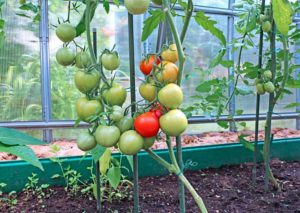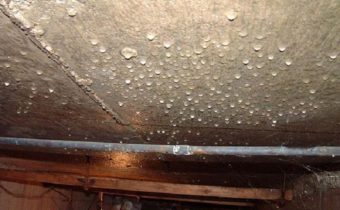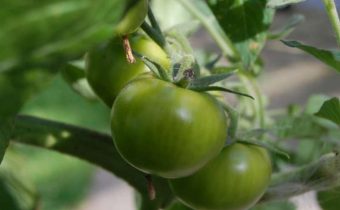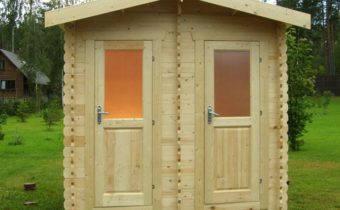Greenhouse from what was
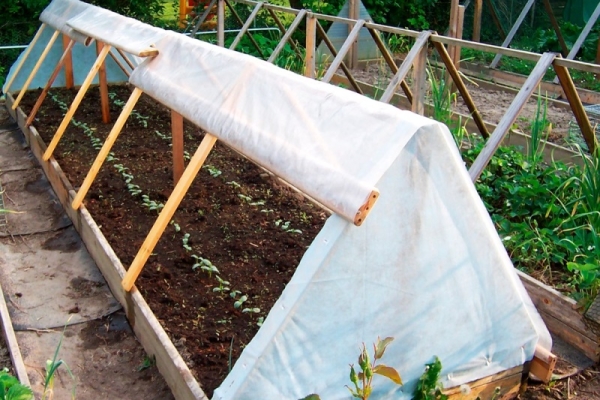
Every self-respecting grower has a greenhouse. Some people buy a finished design, others prefer to do it yourself. In the course are a variety of materials. Due to the use of scrap materials, the cost of home-made greenhouses is low.
What is a greenhouse for?
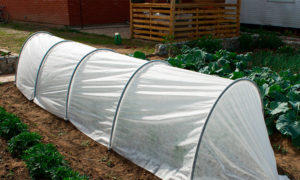
In spring, the weather is changeable, there are often return frosts. To keep tomato seedlings in the house is uncomfortable, it is drawn out. Greenhouses they are built to sow cabbage, cucumbers, flowers for seedlings, plant grown tomatoes in them or to grow early greens.
The direct purpose of the shelter is to protect vegetable ridges from the weather and cold air. With it, the vegetable season begin earlier. Small-sized facilities are heated with biofuels (manure, rotted plant residues) and sunlight.
In the fall, mobile models are used to shelter the ridges with late-ripe vegetables. It helps them to ripen before the onset of frost.
For the cultivation of early vegetables and seedlings, gardeners construct various constructions from scrap materials. They are based on a rigid frame, which is sewn up with glass, polycarbonate, film, and other materials that let in sunlight.
Types of country greenhouses
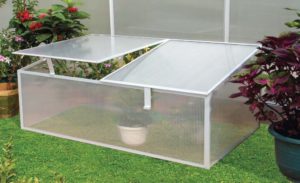
All types of country greenhouses can be divided into three groups. The simplest designs have no basis. For their construction needed arc and covering material. The frame is installed in the right place in the garden. On it throw a film or non-woven material.
The second group of summer houses has a low frame (25-50 cm), arcs, covering fabric. This is a stationary design. Before building it, a trench is dug to the depth of the shovel bayonet, and fresh manure is put into it. Over biofuels poured a layer of fertile soil. A frame is placed on top. In the buried greenhouses on biofuel grown seedlings and early vegetables.
Greenhouses of the greenhouse type have a height of up to 1.2 m. Types of frames:
- arched;
- lean-to;
- duo-pitch
They make such constructions from various materials at hand, they all have a base, and the frames that can be easily removed and opened.
The simplest arched tunnel
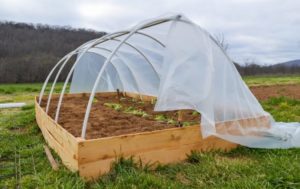
This is a collapsible design. For its construction will need: material, hardware, tools. To manufacture the base in the form of a box you need to have:
- edged board 4 x 15 cm;
- antiseptic;
- self-tapping screws;
- corners.
The optimal width is 1.2 m. The length depends on the size of the section and the amount of material. Boards are sawn according to size. They are covered with a brush with 2-3 layers of antiseptic with a brush. Dried boards rolled in a box. The rigidity of the design gets due to the corners.
Tools that are used in the work:
- roulette;
- screwdriver (screwdriver);
- hacksaw;
- brush;
- marker.
The base is placed on a permanent place, proceed to the installation of arcs, they are conveniently made of PVC pipes with a diameter of 25 mm or more. For their fixation using reinforcement. It is cut into pieces with a length of 0.5 m.
Determined by the distance between the arcs. Intervals must be the same. The optimal step is considered to be 0.5 m pitch, but if the pipes are small, it can be increased to 1 m.The smaller the distance between the arcs, the less the covering fabric sags.
Plants in facilities oriented from north to south get more sunlight.
The installation sites of the arcs mark the marker on the long sides of the box. Next to the labels drive in rebar. They submerge it with a hammer not less than 25 cm, place it outside or inside the frame.
The pipes are cut into pieces with a length of 3 m. They are put on the pins sticking out of the ground. To the frame is fixed with a perforated tape. The design is strengthened by a coupler. It is made from a piece of pipe, laid on top of arcs, rigidly fixed with wire.
Covering material (PVC film, lutrasil) is cut in one piece. Its length is equal to the length of the box + 2 butt heights + 2 allowances of 20–25 cm. To keep the film tight, it is fixed with a broken garden hose. First, it is cut into 3 m pieces, then cut the entire length in half. Put the hose over the film on the arc.
| pros | Minuses |
| ease of use | the design has low strength |
| low cost | the building is poorly ventilated |
| ease of manufacture |
Insulated arched greenhouse
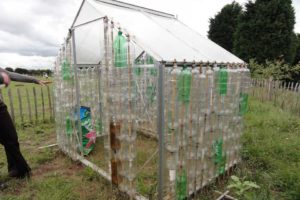
Bottles from colored plastic (green, brown) of the same volume (2 l) are required. Of them build a foundation. The plot is leveled, pegs mark the corners of the structure, and tension the string. They dig a shallow trench, in it put bottles filled with water and closed with lids.
Arcs are formed to form an arch, PVC film or nonwoven covering material is tied onto it. During the day, the sun heats bottled water, at night it gives off heat, protecting seedlings from low temperatures.
From plastic bottles
If you do not throw away plastic bottles from under drinks, then over the winter they will accumulate a lot. In the spring you can make them a greenhouse. In addition to them, you will need other materials:
- rail 20 x 20 mm (length depends on the size of the greenhouse);
- bars 40 x 40 mm;
- PVC film;
- fishing line 1 mm;
- corner fixing;
- self-tapping screws.
From a bar make the base in the form of a rectangle. Corners used to connect. All bottles cut off the bottom. They are dressed on a rail, sticking tightly into each other to make a pipe. The edges of the slats should protrude from below and from above for 3-4 cm.
In the corners of the base set 4 bars, fasten them with corners. Make a top strapping. Three walls are sewn up with pipes from plastic bottles. The protruding ends of the slats are screwed to the horizontal bars with self-tapping screws.
To enhance the structure with a step of 50 cm between the vertical supports pull the line. One side serves as the entrance to the greenhouse, it is curled with a film or a rectangular frame is assembled from the bars. Sew it with pipes from plastic bottles, get a door leaf. It is hung on the hinges.
Greenhouse roof do gable. Sew it with pipes similar to the walls, bottom for tightness duplicate PVC film. The edges of the bars attached furniture stapler. The greenhouse of the bottle has several advantages:
- durable;
- cheap;
- easy to manufacture;
- easily dismantled and transferred to a new location;
- protects plants from low temperatures;
- The material of the bottles retains properties in a wide range of temperatures from -50 ° C to +100 ° C.
How to protect tomatoes in greenhouses from overheating
How to save tomatoes from the heat in the greenhouse - this is an urgent question for those who want to get a good harvest. Growing up ...
Greenhouse from old windows
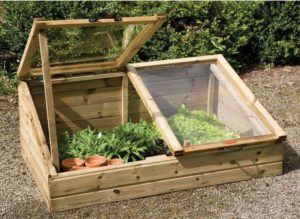
After replacing wooden windows with plastic, the summer resident gets material from which to build a greenhouse. For the construction of the simplest design in the form of a book, a single double-wing frame and a pair of hanging loops are enough. The base of the greenhouse can be a high bed.
For a long recumbent greenhouse frames will need more. A box and edged boards are made of a box, its external dimensions (length, width) should correspond to the size of the window. In order for rainwater not to linger, the height of the back wall must be greater than the front.
To the ends of the outside bolted bars (slats) to close the small gap.
The advantages of a greenhouse frame:
- no need to throw away old frames;
- manufacturing requires a minimum of building materials;
- durable construction;
- the box and the frame can be easily transferred to a new place.
Cucumber hut
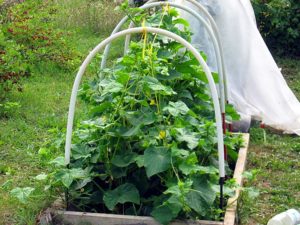
Time for the manufacture of a tent for cucumbers takes a bit. From materials one PVC pipe is required with a diameter of at least 50 mm and pieces 6 are thinner. For a thick borer, a hole is made in the center of the future structure.
The foundation of the whole structure is set in the pit - a thick pipe, with thin tubes stuck in diameter. Their tops are wired, and a plastic bottle is put on top. It will protect the film (non-woven material) from damage.
On the design throw a film. It can be fixed with an old irrigation hose. It needs to be cut into pieces 25-30 cm long, on each to make a longitudinal section. Such an improvised latch is put on each thin pipe closer to the base.
The simplest greenhouse of the vine
A 1.5 mm long vine with a thickness of about 1 cm is used to build an arched greenhouse. In addition to her take an old garden hose. It is cut into pieces with a length of 20 cm. From 2 rods and one piece of hose they make one arc. A length of pipe acts as a fixative, a vine is stuck into it.
Wooden pegs are driven in along the perimeter of the construction with a step of 50 cm; arcs from a rod are attached to them with a wire. On the finished frame tension film or covering material. The design of the rod is very practical, the cost of it is minimal.
Greenhouse sheathing
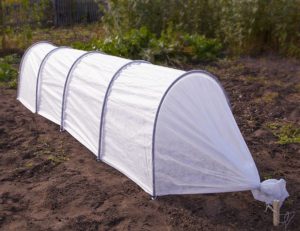
The type of lining depends largely on the material of the frame and its shape. If a it consists of arcsthen use soft materials. For rigid structures any type of plating is suitable:
- film;
- polycarbonate;
- glass;
- non-woven fabric.
Glass
Glass well passes light, keeps heat, serves long. The glass greenhouse is easy to keep clean, it is easy to clean, it can be treated against infection with chemicals.
The frame for the construction of glass should be durable, it is made of pipes (steel, galvanized), metal corners, metal profile, wooden bars. Working with glass requires certain construction skills.
Film
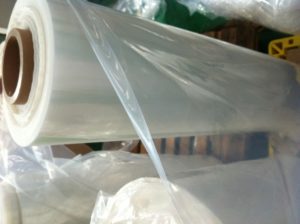
PVC film is inexpensive, so it is most often purchased for covering the greenhouse. It is short-lived. You can count on 1-2 years of operation. Up to 10 seasons will serve a multi-year film for greenhouses. She is not afraid of frost, it does not need to be removed for the winter.
Reinforced film has increased strength, hail, wind, and showers are not afraid of it. A wide range of temperatures at which the material retains its properties allows the use of a reinforced film year-round.
Polycarbonate
Light, transparent material that protects plants from excessive UV radiation, good heat retention. Polycarbonate can be cut with a simple stationery knife. It is easy to attach to the frame of wood, steel profile, plastic pipes.
The standard size of polycarbonate sheet is 2.1 x 6 m.
For the construction of polycarbonate does not need a massive foundation. The design is durable, withstands a thick layer of snow, it is fireproof, it can be operated throughout the year in any climate zone.
Scrap sheath fasteners
The frame is covered with a film, covering material or sheathed with polycarbonate. They are fastened with a stapler, and for reliability they use fixers from improvised means:
- the film is reinforced from the inside with a plastic net for cucumbers or with a fishing net;
- pull the clothesline between the arcs;
- reinforce the construction of wooden planks;
- constructing a frame of pipes and wooden slats, use clips for PVC pipes.
Clips are made from pieces of plastic pipes or pieces of old irrigation hose.
Autumn preparation of the greenhouse for growing tomatoes
A greenhouse is a man-controlled environment bounded by natural conditions, and from how exactly it is ...
Pros and cons of homemade greenhouses
| A plus | Minus |
| Do-it-yourself greenhouse costs less than factory-made | It takes more time to work on a self-made design than build a purchased model. |
| Dimensions of the design can be any | Special tools are needed for work. |
| Used materials can be used (glass, boards, bars) |
Handy materials
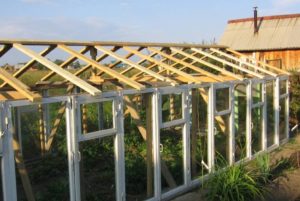
The main details of any greenhouse: frame, base and covering top. For the construction of the base using boards, timber or scrap materials:
- old window frames;
- tires;
- barrels.
For the manufacture of the frame using frames, plastic pipes, fittings, wooden beams, electrical cable, metal profile, bar.
Reviews
Nikolay, St. Petersburg
My neighbor has a greenhouse for 25 years. He made the frame of the metal profile, and sheathed the windshields of the tractor. I buy tomato seedlings from them, always strong and healthy.
Andrey, Tver
I changed the window in the apartment. Old frames were cleared of paint, sanded, covered with several layers of linseed oil. Made of them a shelter for seedlings. For several years I have been growing cucumbers in it. In the autumn I take out the land, in the spring I fill the new one with the manure on the bottom.
Catherine, Moscow region
The husband built a cabbage greenhouse from a big tire from a tractor. He cut out her side parts, filled it with a mixture of garden soil and humus. Two arcs bent of metal rods, put them crosswise and covered with covering material.
Conclusion
Making a greenhouse with your own hands does not take much time. The use of scrap materials reduces the cost of construction. It is possible to operate a self-made construction throughout several seasons.

